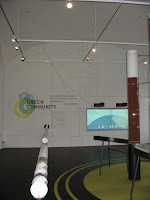 The time-tube in the exhibition tends to sort visitors by age. People will tend to collect at those dates that mean something to them personally. Those of a certain age will inevitably pause at the early 70’s gas crisis and Carter’s installation of solar panels on the White House. Slightly grayer ones will pause in the early 60’s with Rachel Carson. The 20-somethings may have only a vague memory of the Exxon Valdez and probably think that ISTEA is a cold drink. USGBC’s LEED rating system is just over 10 years old. Young people, working for a young organization, on a young idea...with a very, very old context.
The time-tube in the exhibition tends to sort visitors by age. People will tend to collect at those dates that mean something to them personally. Those of a certain age will inevitably pause at the early 70’s gas crisis and Carter’s installation of solar panels on the White House. Slightly grayer ones will pause in the early 60’s with Rachel Carson. The 20-somethings may have only a vague memory of the Exxon Valdez and probably think that ISTEA is a cold drink. USGBC’s LEED rating system is just over 10 years old. Young people, working for a young organization, on a young idea...with a very, very old context.As I led the group through, pausing at whatever communities I thought would resonate, I found myself telling stories about my personal connections with a few of them. I had to offer the choir something more than just preaching. So I mused about being in Santa Monica years ago and wondering what that thing was with the pink parasol roofs--the SMURFF, Santa Monica Urban Runoff and Rainfall Facility. Or visiting Mississippi State and listening to students in the Carl Small Town Center talk about the miracle of sidewalks. Coming out of a post-transcontinental flight stupor and seeing the streets of Mendoza lined with acequias and huge trees.
 Meeting the matriarchs of Stella at the opening.
Meeting the matriarchs of Stella at the opening.As I was reminiscing about Mendoza I noticed one of my own students standing nearby. Valeria is from Mendoza, studying here for a year. And she is, along with a growing number of her Mendocino predecessors, another stitch in an increasingly strong seam that binds me to that faraway place. Through my teaching at the WAAC (Virginia Tech’s Washington Alexandria Architecture Center) I am increasingly bound through my students to such places: Tallinn, London, Weimar, San Luis Obispo, Mexico City, Baton Rouge, Istanbul, Jerusalem, Santiago, Quito...
The opening interactive in Green Community is the slowly spinning globe where visitors can activate different representations of how we are all connected. Population, national boundaries, shipping channels...these never fail to awe our visitors. But there’s no layer that is "people I know" but in my mind’s eye I see it when I’m at the globe. It keeps the world’s condition from being an abstraction and renders it instead as a patchwork of social sustainability, and through that we start to care. The quilt may be an overused metaphor, but it is an accurate one. The swatches themselves aren’t sufficient. A quilt depends on the stitches, and sustainability depends on connectivity...personal connectivity. Mexico is in the news now, and I pay a different kind of attention because I know Maria, Eduardo, Gabriel and Tania are there. Ecuador is having an election, so I think of Patty, Pamela, Jose and David.
I always finish my tours by asking if anyone has any questions, but I’ve never turned the tables and asked if they would take questions from me. I should have started with this USGBC group. My first question would be: how did you come to care? About your neighbors? About far away places? About other species? About the buildt environment? About the very planet? Everything depends on caring. Without it, all the money, technology, cleverness, and innovation will be for naught. Next time, I’ll ask. And then I’ll ask if anyone has any answers.

